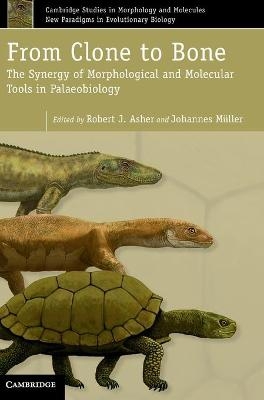
From Clone to Bone
Cambridge University Press (Verlag)
978-1-107-00326-2 (ISBN)
Since the 1980s, a renewed understanding of molecular development has afforded an unprecedented level of knowledge of the mechanisms by which phenotype in animals and plants has evolved. In this volume, top scientists in these fields provide perspectives on how molecular data in biology help to elucidate key questions in estimating paleontological divergence and in understanding the mechanisms behind phenotypic evolution. Paleobiological questions such as genome size, digit homologies, genetic control cascades behind phenotype, estimates of vertebrate divergence dates, and rates of morphological evolution are addressed, with a special emphasis on how molecular biology can inform paleontology, directly and indirectly, to better understand life's past. Highlighting a significant shift towards interdisciplinary collaboration, this is a valuable resource for students and researchers interested in the integration of organismal and molecular biology.
Robert J. Asher is a Lecturer and Curator of Vertebrates in the University Museum of Zoology, Cambridge, UK. He is a vertebrate paleontologist, specializing in mammals, with interests in phylogenetics and development. Johannes Müller is Professor of Paleozoology at the Museum für Naturkunde and Humboldt University, Berlin, Germany. He is a paleobiologist, focusing on the evolutionary diversification of fossil and recent reptiles.
List of contributors; 1. Molecular tools in paleobiology: divergence and mechanisms Robert J. Asher and Johannes Müller; Part I. Divergence: 2. Genomics and the lost world: paleontological insights into genome evolution Chris Organ; 3. Rocking clocks and clocking rocks: a critical look at divergence time estimation in mammals Olaf R. P. Bininda-Emonds, Robin M. D. Beck and Ross D. E. MacPhee; 4. Morphological largess: can morphology offer more and be modeled as a stochastic evolutionary process? Hans C. E. Larsson, T. Alexander Dececchi and Luke B. Harrison; 5. Species selection in the molecular age Carl Simpson and Johannes Müller; Part II. Mechanisms: 6. Reconstructing the molecular underpinnings of morphological diversification: a case study of the Triassic fish Saurichthys Leonhard Schmid; 7. A molecular guide to regulation of morphological pattern in the vertebrate dentition and the evolution of dental development Moya Smith and Zerina Johanson; 8. Molecular biology of the mammalian dentary: insights into how complex skeletal elements can be shaped during development and evolution Neal Anthwal and Abigail S. Tucker; 9. Flexibility and constraint: patterning the axial skeleton in mammals Emily A. Buchholtz; 10. Molecular determinants of marsupial limb integration and constraint Karen E. Sears, Carolyn K. Doroba, Xiaoyi Cao, Dan Xie and Sheng Zhong; 11. A developmental basis for innovative evolution of the turtle shell Shigeru Kuratani and Hiroshi Nagashima; 12. A molecular-morphological study of a peculiar limb morphology: the development and evolution of the mole's 'thumb' Christian Mitgutsch, Michael K. Richardson, Merijn A. G. de Bakker, Rafael Jiménez, José Ezequiel Martín, Peter Kondrashov and Marcelo R. Sánchez-Villagra; 13. Manus horribilis: the chicken wing skeleton Michael K. Richardson; Index.
| Erscheint lt. Verlag | 18.10.2012 |
|---|---|
| Reihe/Serie | Cambridge Studies in Morphology and Molecules: New Paradigms in Evolutionary Bio |
| Zusatzinfo | 8 Tables, black and white; 16 Plates, color; 57 Halftones, unspecified; 8 Line drawings, unspecified |
| Verlagsort | Cambridge |
| Sprache | englisch |
| Maße | 178 x 253 mm |
| Gewicht | 990 g |
| Themenwelt | Naturwissenschaften ► Biologie ► Evolution |
| Naturwissenschaften ► Biologie ► Genetik / Molekularbiologie | |
| Naturwissenschaften ► Geowissenschaften ► Mineralogie / Paläontologie | |
| ISBN-10 | 1-107-00326-1 / 1107003261 |
| ISBN-13 | 978-1-107-00326-2 / 9781107003262 |
| Zustand | Neuware |
| Haben Sie eine Frage zum Produkt? |
aus dem Bereich


